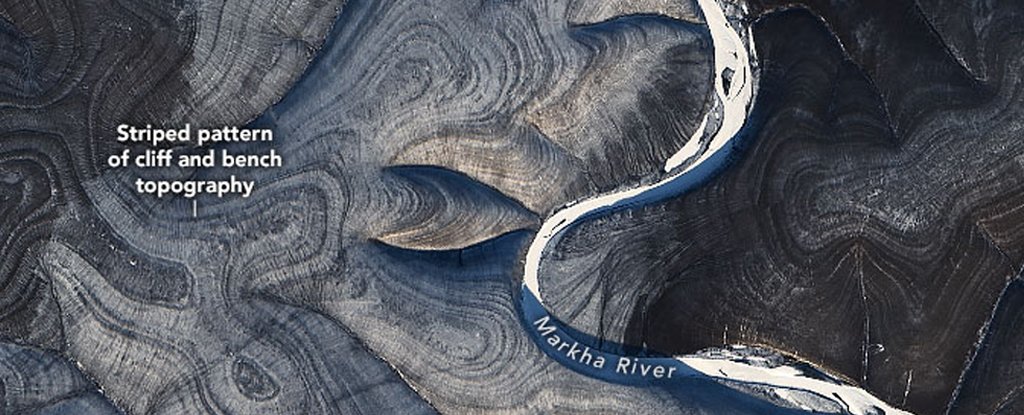
Near the Markha River in Arctic Siberia, the earth undulates in ways that scientists don’t fully understand.
Earlier this week, NASA researchers released a series of satellite images of the quirky crumpled landscape on the agency’s Earth Observatory website. Taken with the Landsat 8 satellite for several years, the photographs show the terrain on both sides of the undulating Markha River with alternating dark and light stripes.
The baffling effect is visible in all four seasons, but is most pronounced in the winter, when the white snow makes the contrast pattern even sharper.
 Striped eddies have puzzled scientists. (NASA Earth Observatory / Landsat 8)
Striped eddies have puzzled scientists. (NASA Earth Observatory / Landsat 8)
Why is this particular section of Siberia so scratched? Scientists are not entirely sure and several experts offered contradictory explanations to NASA.
Related: The Eight Biggest Mysteries on Earth
One possible explanation is written on icy earth. This region of the Central Siberian plateau spends about 9 percent of the year covered in permafrost, according to NASA, although it occasionally thaws at short intervals.
Pieces of earth that are frozen, thawed, and re-frozen continuously are known to adopt strange circular or striped patterns called stamped soil, scientists said in a study published in January 2003 in the journal Science. The effect occurs when soils and stones are naturally ordered during the freeze-thaw cycle.
 The stripes of the Central Siberian plateau vary according to the season. (NASA Earth Observatory)
The stripes of the Central Siberian plateau vary according to the season. (NASA Earth Observatory)
However, other examples of patterned soil, such as the stone circles of Svalbard, Norway, are usually much smaller in scale than the stripes seen in Siberia.
Another possible explanation is erosion. Thomas Crafford, a geologist at the U.S. Geological Survey, told NASA that the streaks resemble a sedimentary rock pattern known as layer geology.
These patterns occur when melting snow or rain drains downward, crushing and dragging pieces of sedimentary rock into piles. Crafford said the process may reveal slabs of sediment that look like slices of a layer cake, with darker stripes representing steeper areas and lighter strips meaning flatter areas.
According to the image above, this type of sedimentary layer would stand out more in winter, when the white snow rests on the flatter areas, making them look even clearer. Crafford added that the pattern fades as it approaches the river, where sediments gather in more uniform piles along the banks after millions of years of erosion.
That explanation seems to fit well, according to NASA. But until the region can be studied closely, it will remain another of these quintessential Siberian curiosities.
Related content:
The 11 largest volcanic eruptions in history
The rarest geological formations in the world
7 ways to change the Earth in the blink of an eye
This article was originally published by Live Science. Read the original article here.